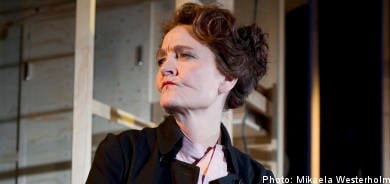The World Economic Forum releases a report each year entitled the Gender Gap Index. In 2007’s report Sweden was named the most equal country in the world. Again. On International Women’s Day, March 8th, Sweden has a lot to be proud of, leaving some to perhaps wonder if there is anything left worth protesting about.
In 2007 the Swedish Union for Theatre, Arts and Media commissioned a report to look into equality within the arts in Sweden. The report, entitled ‘I väntan på vadå’ (What are are we waiting for?), was written by theatre expert Vanja Hermele and was published in the shadow of a state inquiry into the status quo between the sexes on the Swedish stage, ‘Plats på scen’ (literally – room on stage). The findings were not flattering for the “most equal country in the world.”
Only 19 percent of the heads of Sweden’s 27 main theatres were women in 2005/2006. At the city theatres in Stockholm, Gothenburg and Malmö in 2005/2006, 32 percent of the directors and 44 percent of the actors were women. At all of Sweden’s theatres in 2005/2006 the number of plays by female dramatists amounted to 36 percent; at the three main city theatres this figure was 23 percent.
In an interview with Hermele, the art director of the Royal Dramatic Theatre, Staffan Valdemar Holm, opines that women have been so oppressed in history “that they have not even got to hold a pen.” During Valdemar Holm’s tenure as head of Sweden’s most celebrated stage, he has directed only one play by a female dramatist, Hermele points out.
“I think that Valdemar Holm aspires to be fair,” Hermele tells The Local.
“He knows that in order to progress, gender equity is important. But nothing gets done.
”His comment (above) implies that we are progressing. The only thing is it is getting worse – there are less plays written by women put up at the major theatres today than a hundred years ago.”
Strindberg, Strindberg, Ibsen, Strindberg…
Ann Petrén, one of Sweden’s most established actors, features in a short film where three bored society women decide to go to the theatre. After a brief perusal of the culture and arts pages in the newspaper they are left visibly exasperated.
“Strindberg, Ibsen, Pinter, Harwood, Strindberg – again and again, always the same classics! I want to see something else, I have an idea! Follow me.”
That idea became the “Modern Women” project. Petrén, together with Åsa Sarachu, dug deep into the archives of Swedish theatre to find the other half of the dialogues that symbolized the era known as the breakthrough of modern drama – around the turn of the 20th century.
They approached Stockholm City Theatre art director Benny Fredriksson and presented him with a long list of plays by female Swedish playwrights such as Frida Stéenhoff, Victoria Benedictsson and Anne Charlotte Leffler. Eventually they managed to secure an agreement for two plays as well as a series of seminars and an exhibition.
“Any more and it would have been considered woman’s year,” Petrén jokes to The Local.
The theatre scene in this era is described by Åsa Sarachu on the project’s homepage as “an all consuming drama where every play became a response to the others. Theatre had the role of an arena to discuss society’s problems.”
So what happened? What became of the women and their plays?
“The women’s issues that were of utmost relevance at the turn of the century became less so as the vote was won and other changes occurred – the theatre discourse turned elsewhere”
“The fact that history has been largely written by male historians has meant also that definitions of quality and relevance have also been shaped by men. It is wrong to think that it is the best quality drama that survives. It is the drama that is chosen that survives,” Petrén adds.
Petrén’s boss Bennie Fredriksson gave his view in an interview with Hermele:
“In one sense there is an absolute subjectivity. What I think is quality”
Are the issues still relevant today?
“OK, so maybe the subject addressed in our current play, Den Smala Vägen by Frida Stéenhoff (‘The Narrow Road’) – illegitimate children’s inheritance rights, is not the most important issue today but there are broader moral issues to consider which are of continued relevance,” says Petrén.
“It is still controversial to challenge establish norms of the family, many find this provocative.
“No one questions the relevance of Miss Julie (by August Strindberg), which was written in the same era.”
The Modern Women project aims to remind the Swedish theatre world that the plays of Ibsen, Strindberg and others were written in a period of social upheaval, often in dialogue, and that dialogue involved women.
“The impression among much of theatre audiences, which it should be emphasised is often middle-aged women, is that women did not exist. Women took no part in the debate.”
This has had consequences for young dramatists, especially females starting out.
“As in any business one must have idols to be inspired by. Within theatre these idols for young women haven’t been there.”
Frida Stéenhoff wrote ‘Den Smala Vägen’ in 1910. Stéenhof is widely regarded to have been one of the most important advocates of women’s issues but is virtually unknown as a writer. This particular play was chosen, says Petrén, as a homage to a great woman of history who had been forgotten.
So this is a history project first and a dramatic project second?
“This play would never have got off the ground without placing it in a broader context.”
At the same time Petrén complains that many of the journalists who address the work of these women and who have come into contact with the Modern Women project have focused on the “biographical and not the dramatic.”
“The narrative has taken a back seat in Swedish theatre. It is not sufficient to simply put up a play, if it is not one of the established classics. Many people today are attracted more by celebrity.”
One ambition of the project is to push the plays for inclusion in the Swedish literary canon, the pool of plays commonly recognized to be “the classics”. But theatre critic Maria Edström contends that, instead of trying to re-establish “Den Smala Vägen” as major drama, it would have been more interesting to de-construct it further, making the road even narrower.
“I know that what I am going to say is like swearing in church but, it is like looking into a sort of theatrical exhibit. The play’s haughty moral philosophizing is, for me, irritating,” she writes on Sveriges Radio’s webite.
What of the future?
Victoria Benedictsson’s play ‘The Enchanted’ (Den Bergtagna) had a run at the National Theatre in London in the autumn of 2007. The last time the play was presented in Sweden was in 1910. Claire Bayley, who adapted the play for the English stage, told the BBC’s Jane Little that Benedictsson would have claimed her place alongside Strindberg and Ibsen if only her life had not been so tragically cut short by her suicide.
Petrén sees a future to the project and also the potential to run similar projects in other countries.
“I see no reason to believe it is any different in any other country. There are the same male bourgeois structures everywhere.”




 Please whitelist us to continue reading.
Please whitelist us to continue reading.